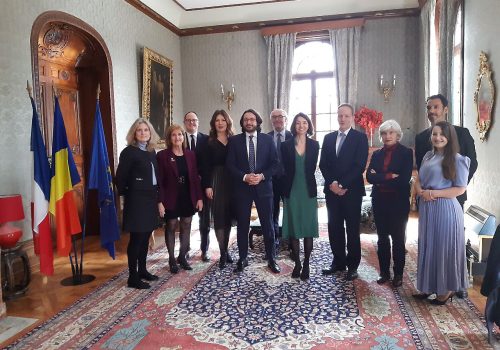Geoeconomic fragmentation is threatening the green energy transition
After decades of efforts to pursue global economic integration, the process is beginning to reverse. Capital flows are slowing, as is cooperation on global crises. This geoeconomic fragmentation is a threat to the global economy, especially when it comes to the fight against climate change. In the absence of highly coordinated international cooperation, the climate issue has no chance of being resolved in an effective and timely manner. Further fragmentation would delay net-zero targets for many economies around the world—and punish lower-income countries that are neither major emitters nor advocates of fragmentation.
Events like the 2008 Global Financial Crisis, the Covid-19 pandemic, Brexit, increased trade tensions between the United States and China, the ongoing war in Ukraine, and coordinated G7 sanctions on Russia have demonstrated the rise of geoeconomic fragmentation. While trade volumes continue to grow, trade relationships around the world are fraying. A 2023 IMF report estimates the cost of trade fragmentation for global economy would be somewhere between 0.2 percent all the way up to 7 percent of global GDP.
Rising trade barriers and trade wars, reduced foreign direct investment (FDI), increased technological decoupling, and faltering multilateralism are the four channels through which geoeconomic fragmentation could impact global climate targets. Here I’ll focus just on geoeconomic fragmentation’s effects on climate change via trade barriers.
The energy transition depends on trade—and on China
More than 50 percent of global greenhouse gas emissions are produced by China, the United States, the EU, and other G7 economies. All have target dates of 2050 to reach net-zero emissions.
Moreover, as shown in the charts below, these economies depend heavily on each other in trade of environmental goods and technologies central to the development of renewable energy and reducing emissions. Hence, trade skirmishes between these economies will pose significant risks to the green energy transition, imposing huge costs on the global economy.
It’s not just the G7 and the EU that depend on China for environmental goods—the whole world does. The Chinese supply chain for clean energy is so critical that, as of now, meaningful global energy transition cannot take place without it. In 2022 alone, China allocated $546 billion towards various investments in solar and wind energy, electric vehicles, and battery technologies. This amount dwarfed combined US and EU investments in these sectors, which amounted to $321 billion in the same year.
On the solar front, according to the International Energy Agency (IEA), China currently dominates the global production of solar panels across all manufacturing stages, boasting a market share that exceeds 80 percent and is expected to grow to 95 percent in the coming year. This should not come as a surprise given that China’s investment in the photovoltaic (PV) industry over the past decade surpassed $50 billion, a figure ten times greater than that of Europe.
On the wind front, Chinese manufacturers have also dominated the global market. About 60 percent of the world’s wind installed capacity is sourced from China. High-storage batteries are central to the energy transition and on this front too, China dominates the global market. Nearly 80 percent of the world’s battery manufacturing capacity is housed in China. This dominance is further exacerbated by China’s vertical integration across the entire electric vehicle (EV) supply chain, from mining to EV manufacturing.
Finally, rare earth minerals are critical resources for high-storage batteries and other high-tech industries. China dominates this space with more than 70 percent of the world’s rare earth minerals processed by Chinese companies. At present, it is estimated that China is home to roughly 34 percent of the world’s rare earths reserves.
Geoeconomic fragmentation will slow the energy transition
Therefore, any trade frictions with China in the form of tariffs, quotas, or export controls are likely to result in Beijing’s retaliation, and if the above-mentioned industries and commodities are part of China’s retaliatory measures, global climate targets will be negatively impacted. In fact, this is already happening. In July 2023, in response to US, Japanese, and Dutch export controls on semiconductor chips to China, Beijing announced that it was restricting exports of gallium and germanium, two crucial metals needed for the green energy transition and the development of advanced semiconductor technologies. China produces 94 percent and 83 percent of the world’s gallium and germanium, respectively. Some analysts have suggested these measures were largely symbolic; nonetheless, there is a real possibility of future retaliatory measures slowing trade in areas critical for the energy transition. For example, according to the IMF, “In our hypothetical scenario where trade of critical minerals between blocs is disrupted, investment in renewable energy and electric vehicles could be lower by as much as 30 percent by 2030, compared to an unfragmented world.”
The United States, the EU, and their allies are actively looking to create a more diversified supply chain in the green energy sector in the long run and reduce their dependence on Chinese supply chains. However, given the US and EU’s regulatory hurdles to mine in their countries and other places in the world—mainly because of environmental and human rights concerns—such plans will take at least a decade to reach an operational level equivalent to that of present-day China.
Given the pressing climate challenge, that is a very long time and the world simply does not have the luxury to wait on a more diversified green energy supply chain to reduce its emissions. At today’s emission rates, we will reach the 1.5 degrees Celsius target in only six years. In other words, limiting global warming to the 1.5 degrees Celsius target will require reducing greenhouse gas emissions to zero by around 2035.
The world’s largest economies need to seriously heed the negative climate impacts of geoeconomic fragmentation on the livelihood of the world’s 4.2 billion population residing in low and lower-middle-income economies. These economies are only responsible for 17 percent of the global CO2 emissions but bear the brunt of climate change and any delays in green transition. The Bretton Woods Institutions (BWIs) have an important role to play in reducing geoeconomic fragmentation and promoting multilateralism in this increasingly splintered global economy. This will be challenging, as China, the United States, EU and other G7 economies will likely prioritize their own national interests and security considerations over global welfare and climate. However, there is much that the BWIs can do to ameliorate or reverse some of negative impacts of fragmentation on climate issues while also improving their effectiveness and efficiency operating in a more fragmented global economy. For example, the World Bank and WTO should encourage their member countries to advocate for policies that make “green corridors” a reality, where production and trade in environmental goods and services are safeguarded from fragmentation and rivalry between world’s leading producers and exporters of such goods and services.
Finally, let’s not forget that besides its negative impacts on the environment, geoeconomic fragmentation has other significant effects on the global economy. That is why the IMF’s managing director has called on world leaders to resist it for the sake of the global economy, continued prosperity of humanity, and most importantly, the future of the climate. COP28 is an ideal opportunity for the world’s leaders from the private and public sector to devise pathways and reach concrete agreements to reverse and reduce geoeconomic fragmentation, or at the very least safeguard climate targets from its detrimental impacts.
Amin Mohseni-Cheraghlou is a macroeconomist with the GeoEconomics Center and leads the Atlantic Council’s Bretton Woods 2.0 Project. He is also a senior lecturer of economics at American University in Washington DC. Follow him on X at @AMohseniC.

At the intersection of economics, finance, and foreign policy, the GeoEconomics Center is a translation hub with the goal of helping shape a better global economic future.
Further reading
Tue, Apr 4, 2023
Five ways the World Bank can redefine its role in the global economy
New Atlanticist By Nicole Goldin, Mrugank Bhusari
With a new president on the horizon and an appetite for reform in the US and beyond, the World Bank is ready for change. It can start by focusing on these five policy priorities.
Tue, Apr 18, 2023
Decarbonization solutions for addressing Europe’s green industrial policy challenge
Event Recap By
The Atlantic Council co-hosted a high-level workshop on “Decarbonization solutions for addressing Europe’s green industrial policy challenge” in Paris with the German Council on Foreign Relations (DGAP) and Groupe d’études geopolitiques (GEG).
Image: Construction of a wind turbine from the air

